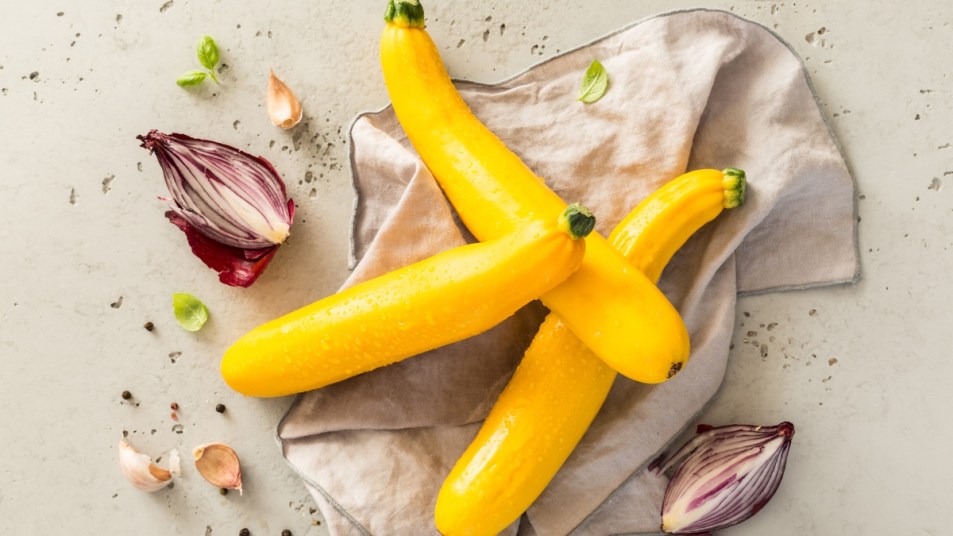This Easy Vegetable Side Dish Can Boost Bone Strength, Kickstart Your Immunity, and Help Regulate Blood Sugar

Have you been looking for a quick and nutritious side dish that also tastes good? Whipping up something nutritious isn’t as easy as it sounds. Healthy eating often requires lots of prep time and costs more than your typical instant mashed potatoes. Fortunately, we’ve got a simple, cost-effective suggestion: sautéed squash, onions, and garlic.
These three vegetables are rich in nutrients that will boost your health as we brace for flu season. According to celebrity chef and certified nutritionist Serena Poon, squash, onions, and garlic all contain unique vitamins and minerals that are essential to the health of your bones, immune system, and cardiovascular system.
“One cup of cooked summer squash offers approximately 19 percent of the recommended daily value of manganese,” Poon says. “Manganese is an important mineral that supports bone formation, reproductive health, immune response, and nutrient metabolism.” Indeed, the connection between manganese and bone health is well established. A study published in the Journal of Nutrition found that postmenopausal women can slow down bone loss by consuming small amounts of manganese along with calcium and other trace minerals. The findings were especially true for older women in the study.
Manganese may also help the body regulate blood sugar. As shown in a study from the Journal of Biological Trace Element Research, deficiencies in manganese and other trace minerals may play a role in the development of type 2 diabetes. The Journal of Trace Elements in Man and Animals notes that the pancreas contains large amounts of manganese and may use this mineral to regulate insulin secretion.
Keep in mind that the body needs only small amounts of manganese to function. So, it’s usually best to obtain this mineral through your diet and not a supplement. “It would be rare for someone in the United States to have a diet that is deficient in this mineral,” Poon adds.
Onions are another powerhouse vegetable with potent anti-inflammatory nutrients. “Onions contain a polyphenol called quercetin that is a powerful antioxidant,” Poon says. “Quercetin also provides anti-inflammatory, antiviral and anti-carcinogenic properties. It is really one of the most wonderful compounds found in plant foods.”
Quercetin, a plant pigment that gives many vegetables their red, orange, and yellow colors, does an excellent job of taking down inflammation in the body. Research shows that this antioxidant can prevent damage caused by “bad” LDL cholesterol, reduce blood pressure, and lower a person’s risk of atherosclerosis. It may even reduce allergy symptoms and improve the function of the immune system. In fact, a study from the Molecules Journal states that quercetin can reduce inflammation of the lungs in asthma patients.
As for garlic, Poon says that humans have long known about its medicinal properties. “Garlic has been used as a therapeutic food for centuries,” she explains. “The active components of garlic are organosulfur compounds, which provide anti-inflammatory effects and have also been shown to help protect against an array of diseases such as neurodegenerative conditions, cardiovascular diseases, cancer, and diabetes. Garlic has also been shown to support balance and strength in the immune system.”
In a review published by the Journal of Immunology Research, scientists explained just how much garlic can benefit the immune system. Recent experiments indicate that garlic enhances immunity by stimulating macrophages and lymphocytes in the body. Macrophages are a type of white blood cell that can kill foreign microorganisms and call other immune cells into action. Lymphocytes are cells that produce antibodies that destroy invading viruses or bacteria.
“Garlic is an incredible little bulb,” Poon adds. “It also supplies effects that can protect against cancer, cardiovascular and metabolic disorders, blood pressure, and diabetes.”
Who knew that a simple side dish of squash, onions, and garlic could become a big investment in your health? To make it, we suggest adding olive oil or avocado oil (heart-healthy fats!) and minced garlic to a pan on low heat. Next, toss in some thinly sliced onions and yellow squash. Sauté until tender. Add salt and pepper to taste, and you’re done.
If you’re wondering about serving size, Poon recommends about ¾ cup along with the rest of your meal. “That would be enough to gather the phytonutrients and antioxidants and provide a nice balance with the rest of your meal,” she says.
In addition, Poon suggests pairing this these three veggies with foods that offer other important nutrients. “This dish supplies a lot of phytonutrients and fiber, and you would want to pair it with a meal that contains protein and fat, and potentially a whole grain, like quinoa or farro,” she explains. “I would opt to cook the meal in cold-pressed avocado oil for added antioxidant benefits. Some options for a main to pair with this yellow squash meal include tempeh with a cashew cream sauce, a rain bowl with ancient grains, avocado, and beans or tofu, or a portion of fatty fish and an ancient grain.”
Ultimately, thinking about your meals in terms of their health benefits could help you plan out tasty, simplified lunches and dinners. This effortless veggie side dish is a great one to have in your back pocket.
















